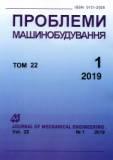Heat Transfer During Subcooled Boiling in Tubes (A Review)
Keywords:
subcooled boiling, nucleate boiling, forced convection, models of subcooled boiling, principle of superposition, ammoniaAbstract
This article provides a review of the correlations and models for determining the intensity of heat transfer during subcooled boiling in pipes. As a rule, correlations are based on dimensionless similarity numbers, while heat exchange models with subcooled boiling use the principle of superposition of the components of heat transfer during forced convection and developed nucleate boiling. Various authors propose different approaches to the implementation of the principle of superposition. This article presents an analysis of the advantages and disadvantages of the correlations and models. These advantages and disadvantages were determined both by analyzing the physical laws of subcooled boiling and by comparing the results that were obtained by the authors of this article by means of various models of subcooled boiling with the experimental data obtained during the study of heat transfer during the subcooled boiling of ammonia in a cylindrical heated tube. The tube diameter d was 6.9 mm, length L was 150 mm, inlet subcooling was ~5 K, saturation temperature range was 61...65 °C, mass flow rate was 7.5 g/s, and heat flux density range was 5...18 W/cm2. As a result of the review and comparison with the experimental data, it was determined that the existing correlations and models describe the subcooled boiling of ammonia with insufficient accuracy, especially in the area of the combined effect of forced convection and nucleate boiling. Therefore, it is necessary either to refine the existing correlations and models, or develop new models for a more precise description of the subcooled boiling heat transfer of ammonia in heated tubes in the parameter range specified above.
References
Shaw, F. D. (1972). Boiling heat transfer to subcooled liquids under the conditions of forced convection. Trans. Inst. Chem. Eng., no. 50, pp. 76–84.
Prodanovic, V. (2001). Bubble behavior in flow boiling at low pressures and flow rates. A thesis submitted in partial fulfilment of the requirements for the degree of doctor of philosophy. The University of British Columbia, 179 p.
(2000). Fizicheskiye osnovy energetiki. Izbrannyye trudy po teploobmenu, gidrodinamike, termodinamike [Physical foundations of energy. Selected works on heat transfer, hydrodynamics, thermodynamics].Moscow: Mosk. energ. in-t, 388 p. (in Russian).
Chen, J. C. (1963). A correlation for boiling heat transfer to saturated fluids in convective flow. Proc. of 6th National Heat Transfer Conf. August 11–14, 1963. Boston, USA. ASME preprint 63-HT-34.
Winterton, Z. L. (1991). A general correlation for saturated and subcooled flow boiling in tubes and annuli, based on a nucleate pool boiling equation. Int. J. Heat Mass Transfer, vol. 34, no. 11, pp. 2759–2766. https://doi.org/10.1016/0017-9310(91)90234-6
Kutateladze, S. S. (1961). Boiling heat transfer. Int. J. Heat Mass Transfer, no. 5, pp. 31–45. https://doi.org/10.1016/0017-9310(61)90059-X
Bowring, R. W. (1962). Physical model based on bubble detachment and calculation of steam voidage in the subcooled region of a heated channel. HPR-10, Institutt for Atomenergi, Halden, Norway.
Engelberg-Forster, K. (1959). Heat transfer to a boiling liquid - mechanism and correlations. Trans. ASME J. Heat Transfer. Ser. C., no. 81, pp. 43–53.
Rohsenow, W. M. (1952). A method of correlating heat transfer data for surface boiling of liquids. Trans. ASME J. Heat Transfer, no. 74, pp. 969.
Bergles, A. E. (1963). The determination of forced convection surface boiling heat transfer. Proc. of 6th National Heat Transfer Conf. August 11–14, 1963. Boston, USA. ASME Paper 63-HT-22.
Kandlikar, S. G. (1998). Heat transfer characteristics in partial boiling, fully developed boiling, and significant void flow regions of subcooled flow boiling. J. Heat Transfer, vol. 120, pp. 395–401. https://doi.org/10.1115/1.2824263
Hsu, Y. Y. (1962). On the size range of active nucleation cavities on a heating surface. ASME J. Heat Transfer, vol. 84, pp. 207–216. https://doi.org/10.1115/1.3684339
Sato, T. (1964). On the conditions of incipient subcooled boiling with forced convection. Bulletin JSME, vol. 7, no. 26, pp. 392–398. https://doi.org/10.1299/jsme1958.7.392
Downloads
Published
Issue
Section
License
Copyright (c) 2019 P. G. Gakal, G. A. Gorbenko, R. Yu. Turna, E. R. Reshitov

This work is licensed under a Creative Commons Attribution-NoDerivatives 4.0 International License.
All authors agree with the following conditions:
- The authors reserve the right to claim authorship of their work and transfer to the journal the right of first publication of the work under the license agreement (the agreement).
- Authors have a right to conclude independently additional agreement on non-exclusive spreading the work in the form in which it was published by the jpurnal (for example, to place the work in institution repository or to publish as a part of a monograph), providing a link to the first publication of the work in this journal.
- Journal policy allows authors to place the manuscript in the Internet (for example, in the institution repository or on a personal web sites) both before its submission to the editorial board and during its editorial processing, as this ensures the productive scientific discussion and impact positively on the efficiency and dynamics of citation of published work (see The Effect of Open Access).

